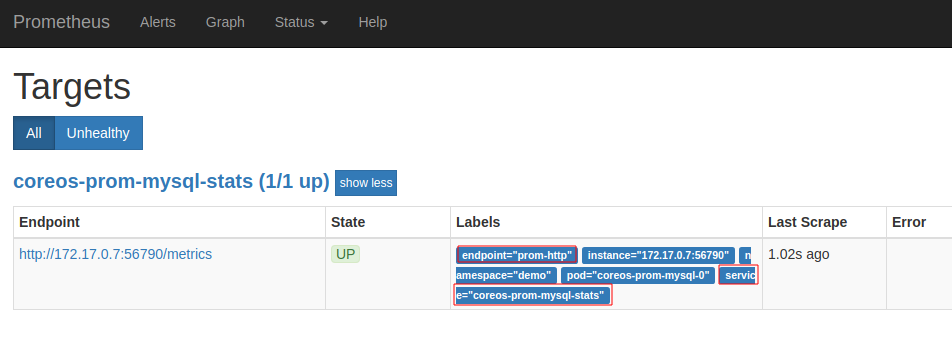New to KubeDB? Please start here.
Monitoring MySQL Using Prometheus operator
Prometheus operator provides simple and Kubernetes native way to deploy and configure Prometheus server. This tutorial will show you how to use Prometheus operator to monitor MySQL database deployed with KubeDB.
Before You Begin
At first, you need to have a Kubernetes cluster, and the kubectl command-line tool must be configured to communicate with your cluster. If you do not already have a cluster, you can create one by using kind.
To learn how Prometheus monitoring works with KubeDB in general, please visit here.
To keep database resources isolated, this tutorial uses a separate namespace called
demothroughout this tutorial. Run the following command to prepare your cluster:$ kubectl create ns demo namespace/demo createdWe need a Prometheus operator instance running. If you don’t already have a running instance, deploy one following the docs from here.
If you already don’t have a Prometheus server running, deploy one following tutorial from here.
Note: YAML files used in this tutorial are stored in docs/guides/mysql/monitoring/prometheus-operator/yamls folder in GitHub repository kubedb/docs.
Find out required labels for ServiceMonitor
We need to know the labels used to select ServiceMonitor by a Prometheus crd. We are going to provide these labels in spec.monitor.prometheus.labels field of MySQL crd so that KubeDB creates ServiceMonitor object accordingly.
At first, let’s find out the available Prometheus server in our cluster.
$ kubectl get prometheus --all-namespaces NAMESPACE NAME VERSION REPLICAS AGE default prometheus 1 2m19s If you don’t have any Prometheus server running in your cluster, deploy one following the guide specified in Before You Begin section.
Now, let’s view the YAML of the available Prometheus server prometheus in default namespace.
$ kubectl get prometheus -n default prometheus -o yaml apiVersion: monitoring.coreos.com/v1 kind: Prometheus metadata: annotations: kubectl.kubernetes.io/last-applied-configuration: | {"apiVersion":"monitoring.coreos.com/v1","kind":"Prometheus","metadata":{"annotations":{},"labels":{"prometheus":"prometheus"},"name":"prometheus","namespace":"default"},"spec":{"replicas":1,"resources":{"requests":{"memory":"400Mi"}},"serviceAccountName":"prometheus","serviceMonitorNamespaceSelector":{"matchLabels":{"prometheus":"prometheus"}},"serviceMonitorSelector":{"matchLabels":{"release":"prometheus"}}}} creationTimestamp: "2020-08-25T04:02:07Z" generation: 1 labels: prometheus: prometheus ... manager: kubectl operation: Update time: "2020-08-25T04:02:07Z" name: prometheus namespace: default resourceVersion: "2087" selfLink: /apis/monitoring.coreos.com/v1/namespaces/default/prometheuses/prometheus uid: 972a50cb-b751-418b-b2bc-e0ecc9232730 spec: replicas: 1 resources: requests: memory: 400Mi serviceAccountName: prometheus serviceMonitorNamespaceSelector: matchLabels: prometheus: prometheus serviceMonitorSelector: matchLabels: release: prometheus spec.serviceMonitorSelectorfield specifies which ServiceMonitors should be included. The Above labelrelease: prometheusis used to selectServiceMonitorsby its selector. So, we are going to use this label inspec.monitor.prometheus.labelsfield of MySQL crd.spec.serviceMonitorNamespaceSelectorfield specifies that theServiceMonitorscan be selected outside the Prometheus namespace by Prometheus using namespace selector. The Above labelprometheus: prometheusis used to select the namespace where theServiceMonitoris created.
Add Label to database namespace
KubeDB creates a ServiceMonitor in database namespace demo. We need to add label to demo namespace. Prometheus will select this namespace by using its spec.serviceMonitorNamespaceSelector field.
Let’s add label prometheus: prometheus to demo namespace,
$ kubectl patch namespace demo -p '{"metadata":{"labels": {"prometheus":"prometheus"}}}' namespace/demo patched Deploy MySQL with Monitoring Enabled
At first, let’s deploy an MySQL database with monitoring enabled. Below is the MySQL object that we are going to create.
apiVersion: kubedb.com/v1 kind: MySQL metadata: name: coreos-prom-mysql namespace: demo spec: version: "9.1.0" deletionPolicy: WipeOut storage: storageClassName: "standard" accessModes: - ReadWriteOnce resources: requests: storage: 1Gi monitor: agent: prometheus.io/operator prometheus: serviceMonitor: labels: release: prometheus interval: 10s Here,
monitor.agent: prometheus.io/operatorindicates that we are going to monitor this server using Prometheus operator.monitor.prometheus.labelsspecifies that KubeDB should createServiceMonitorwith these labels.monitor.prometheus.intervalindicates that the Prometheus server should scrape metrics from this database with 10 seconds interval.
Let’s create the MySQL object that we have shown above,
$ kubectl create -f https://github.com/kubedb/docs/raw/v2025.6.30/docs/guides/mysql/monitoring/prometheus-operator/yamls/prom-operator-mysql.yaml mysql.kubedb.com/prom-operator-mysql created Now, wait for the database to go into Running state.
$ watch -n 3 kubectl get mysql -n demo coreos-prom-mysql Every 3.0s: kubectl get mysql -n demo coreos-prom-mysql suaas-appscode: Tue Aug 25 11:53:34 2020 NAME VERSION STATUS AGE coreos-prom-mysql 9.1.0 Running 2m53s KubeDB will create a separate stats service with name {MySQL crd name}-stats for monitoring purpose.
$ kubectl get svc -n demo --selector="app.kubernetes.io/instance=coreos-prom-mysql" NAME TYPE CLUSTER-IP EXTERNAL-IP PORT(S) AGE coreos-prom-mysql ClusterIP 10.103.228.135 <none> 3306/TCP 3m36s coreos-prom-mysql-gvr ClusterIP None <none> 3306/TCP 3m36s coreos-prom-mysql-stats ClusterIP 10.106.236.14 <none> 56790/TCP 50s Here, coreos-prom-mysql-stats service has been created for monitoring purpose.
Let’s describe this stats service.
$ kubectl describe svc -n demo coreos-prom-mysql-stats Name: coreos-prom-mysql-stats Namespace: demo Labels: app.kubernetes.io/name=mysqls.kubedb.com app.kubernetes.io/instance=coreos-prom-mysql kubedb.com/role=stats Annotations: monitoring.appscode.com/agent: prometheus.io/operator Selector: app.kubernetes.io/name=mysqls.kubedb.com,app.kubernetes.io/instance=coreos-prom-mysql Type: ClusterIP IP: 10.106.236.14 Port: prom-http 56790/TCP TargetPort: prom-http/TCP Endpoints: 10.244.2.6:56790 Session Affinity: None Events: <none> Notice the Labels and Port fields. ServiceMonitor will use these information to target its endpoints.
KubeDB will also create a ServiceMonitor crd in demo namespace that select the endpoints of coreos-prom-mysql-stats service. Verify that the ServiceMonitor crd has been created.
$ kubectl get servicemonitor -n demo NAME AGE kubedb-demo-coreos-prom-mysql 3m16s Let’s verify that the ServiceMonitor has the label that we had specified in spec.monitor section of MySQL crd.
$ kubectl get servicemonitor -n demo kubedb-demo-coreos-prom-mysql -o yaml apiVersion: monitoring.coreos.com/v1 kind: ServiceMonitor metadata: creationTimestamp: "2020-08-25T05:53:27Z" generation: 1 labels: release: prometheus operation: Update time: "2020-08-25T05:53:27Z" ... name: kubedb-demo-coreos-prom-mysql namespace: demo ownerReferences: - apiVersion: v1 blockOwnerDeletion: true controller: true kind: Service name: coreos-prom-mysql-stats uid: cf4ce3ec-a78e-4828-9fee-941c77eb965e resourceVersion: "28659" selfLink: /apis/monitoring.coreos.com/v1/namespaces/demo/servicemonitors/kubedb-demo-coreos-prom-mysql uid: 9cec794a-dfee-49dc-a809-6c9d6faac1df spec: endpoints: - bearerTokenSecret: key: "" honorLabels: true interval: 10s path: /metrics port: prom-http namespaceSelector: matchNames: - demo selector: matchLabels: app.kubernetes.io/name: mysqls.kubedb.com app.kubernetes.io/instance: coreos-prom-mysql kubedb.com/role: stats Notice that the ServiceMonitor has label release: prometheus that we had specified in MySQL crd.
Also notice that the ServiceMonitor has selector which match the labels we have seen in the coreos-prom-mysql-stats service. It also, target the prom-http port that we have seen in the stats service.
Verify Monitoring Metrics
At first, let’s find out the respective Prometheus pod for prometheus Prometheus server.
$ kubectl get pod -n default -l=app=prometheus NAME READY STATUS RESTARTS AGE prometheus-prometheus-0 3/3 Running 1 121m Prometheus server is listening to port 9090 of prometheus-prometheus-0 pod. We are going to use port forwarding to access Prometheus dashboard.
Run following command on a separate terminal to forward the port 9090 of prometheus-prometheus-0 pod,
$ kubectl port-forward -n default prometheus-prometheus-0 9090 Forwarding from 127.0.0.1:9090 -> 9090 Forwarding from [::1]:9090 -> 9090 Now, we can access the dashboard at localhost:9090. Open http://localhost:9090 in your browser. You should see prom-http endpoint of coreos-prom-mysql-stats service as one of the targets.

Check the endpoint and service labels marked by red rectangle. It verifies that the target is our expected database. Now, you can view the collected metrics and create a graph from homepage of this Prometheus dashboard. You can also use this Prometheus server as data source for Grafana and create beautiful dashboard with collected metrics.
Cleaning up
To cleanup the Kubernetes resources created by this tutorial, run following commands
# cleanup database kubectl delete -n demo my/coreos-prom-mysql # cleanup Prometheus resources if exist kubectl delete -f https://raw.githubusercontent.com/appscode/third-party-tools/master/monitoring/prometheus/coreos-operator/artifacts/prometheus.yaml kubectl delete -f https://raw.githubusercontent.com/appscode/third-party-tools/master/monitoring/prometheus/coreos-operator/artifacts/prometheus-rbac.yaml # cleanup Prometheus operator resources if exist kubectl delete -f https://raw.githubusercontent.com/prometheus-operator/prometheus-operator/release-0.41/bundle.yaml # delete namespace kubectl delete ns demo Next Steps
- Monitor your MySQL database with KubeDB using out-of-the-box builtin-Prometheus.
- Detail concepts of MySQL object.
- Detail concepts of MySQLVersion object.
- Initialize MySQL with Script.
- Use private Docker registry to deploy MySQL with KubeDB.
- Want to hack on KubeDB? Check our contribution guidelines.






























